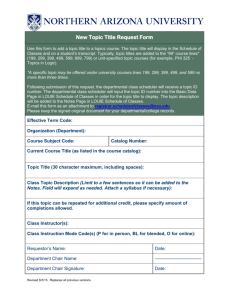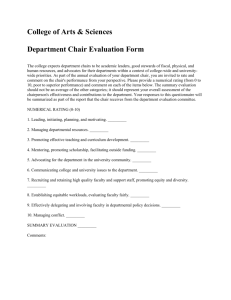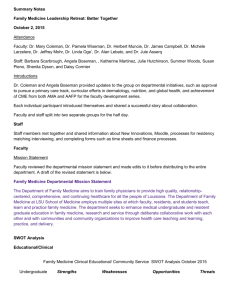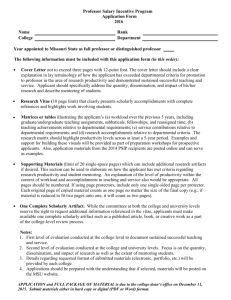Faculty Development Program for the Ohio State University
advertisement
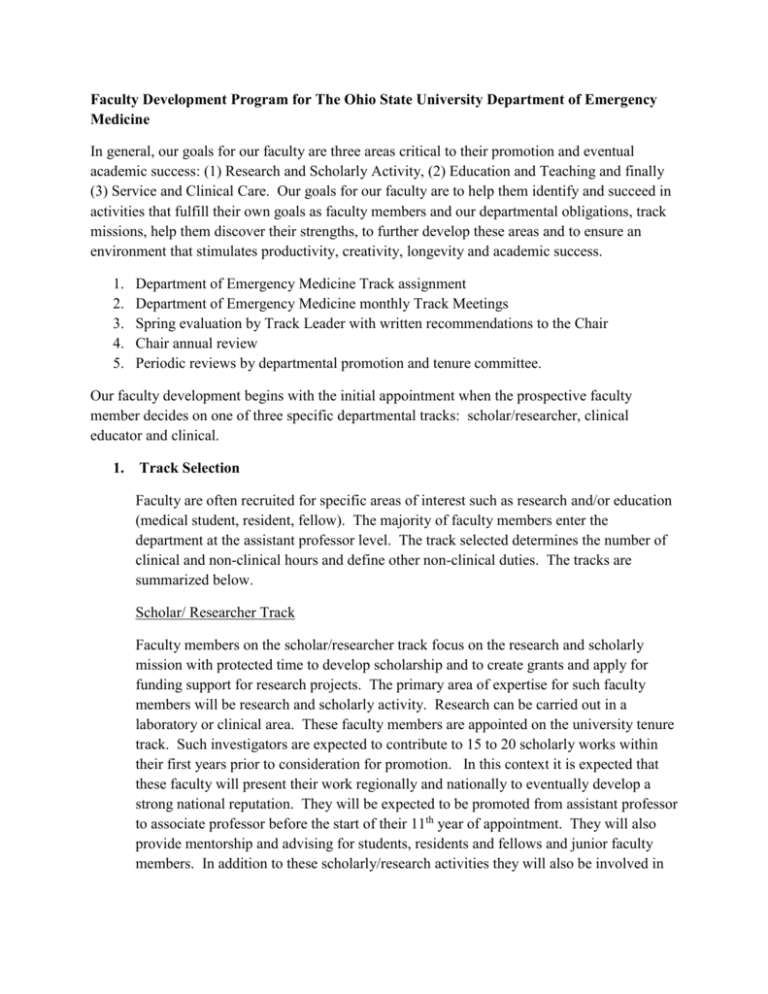
Faculty Development Program for The Ohio State University Department of Emergency Medicine In general, our goals for our faculty are three areas critical to their promotion and eventual academic success: (1) Research and Scholarly Activity, (2) Education and Teaching and finally (3) Service and Clinical Care. Our goals for our faculty are to help them identify and succeed in activities that fulfill their own goals as faculty members and our departmental obligations, track missions, help them discover their strengths, to further develop these areas and to ensure an environment that stimulates productivity, creativity, longevity and academic success. 1. 2. 3. 4. 5. Department of Emergency Medicine Track assignment Department of Emergency Medicine monthly Track Meetings Spring evaluation by Track Leader with written recommendations to the Chair Chair annual review Periodic reviews by departmental promotion and tenure committee. Our faculty development begins with the initial appointment when the prospective faculty member decides on one of three specific departmental tracks: scholar/researcher, clinical educator and clinical. 1. Track Selection Faculty are often recruited for specific areas of interest such as research and/or education (medical student, resident, fellow). The majority of faculty members enter the department at the assistant professor level. The track selected determines the number of clinical and non-clinical hours and define other non-clinical duties. The tracks are summarized below. Scholar/ Researcher Track Faculty members on the scholar/researcher track focus on the research and scholarly mission with protected time to develop scholarship and to create grants and apply for funding support for research projects. The primary area of expertise for such faculty members will be research and scholarly activity. Research can be carried out in a laboratory or clinical area. These faculty members are appointed on the university tenure track. Such investigators are expected to contribute to 15 to 20 scholarly works within their first years prior to consideration for promotion. In this context it is expected that these faculty will present their work regionally and nationally to eventually develop a strong national reputation. They will be expected to be promoted from assistant professor to associate professor before the start of their 11th year of appointment. They will also provide mentorship and advising for students, residents and fellows and junior faculty members. In addition to these scholarly/research activities they will also be involved in all department related educational activities (see Educator Track) as well as activities related to clinical service. Examples of Academic/Service activities: Obtaining external grant research funding Performing original research Publishing original research manuscripts Presentation of research abstracts and other related presentations National research meeting attendance Peer review for journals and granting agencies Research mentorship of research fellows, gradate students, medical students and residents Faculty advising for residents and resident research projects Mentorship of new/junior research faculty Other activities as appropriate Educator Track Faculty members on the clinical educator track focus on the education of students, residents, fellows and faculty with protected time to develop either educational or clinical areas of expertise. Such faculty will typically be appointed to the regular clinical university track. It is anticipated that such faculty members will organize, develop and supervise our efforts to educate medical students, emergency medicine residents, fellows and faculty. They are expected to participate in leadership of educational activities such as the emergency medicine residency program, the medical student rotations and fellowships. Such individuals will be responsible for the innovation within the educational programs. Residency and medical student activities include didactic lectures, curriculum development, bedside teaching and leading and teaching small groups. These faculty members will also be involved in educational research and, in addition to obtaining funding for their projects, they will also be expected to contribute to the literature in research and innovation and other scholarship endeavors. Examples of Academic/Service activities: All department-related research activities (see Scholar/Researcher Track list of activities) Resident coordination (with Emergency Medicine and Family Medicine) o Resident Advising o Small Group Leaders o Lectures o Case development for small groups and simulation Medical student coordination o Podcasts (question generation) o Simulation supervision o Small Group Facilitators o Evaluation Committee 2 o o o o Advanced Topics in Emergency Medicine (ATEM) lectures Emergency Medicine Interest Group (EMIG) participation Undergraduate Student Interest Group (USIG) participation Medical Student lectures (airway, toxicology, ultrasound shock, acute wound management, suturing workshop, the undifferentiated patient) o Honors US lectures / hands-on / simulation o Clinical Skills Immersion Experience (CSIE) o Case development for small groups and simulation Organized medicine activities (local, state, national, international) Departmental committees Medical Center committees College of Medicine committees / activities (not inclusive) o Med 3/4 Academic Program Committee o Admissions Committee o Clinical Academic Standing Committee o Preclinical Academic Standing Committee o Learning Society o Objective Structured Clinical Exam (OSCE) Committee o Preceptorships o Student Advising ED throughput/operations QA/QI work Core measures work EMS liaison Central Ohio Trauma System (COTS) activities (EMS, stroke, MI, trauma, disaster, etc) Other activities as appropriate Clinical Track Faculty members on the clinical track have the greatest contribution to our clinical and service commitment of our department. Although they will be expected to participate to some extent in scholarly, research and educational activities their primary focus will be clinical service which includes bedside teaching opportunities with medical students and residents. In addition to clinical services in the ED (Main and East), we also provide wound care and hyperbaric medicine. Examples of Academic/Service activities: All department-related educational activities (see Educator Track list of activities) All department-related research activities (see Scholar/Researcher Track list of activities) ED throughput/operations QA/QI work Core measures work 3 SANE program activities Resident coordination (EM/FM) Medical student coordination Organized medicine activities (local, state, national, international) Departmental committees Medical Center committees College of Medicine committees EMS liaison Central Ohio Trauma System (COTS) activities (EMS, stroke, MI, trauma, disaster, etc) Other activities as appropriate 2. Department of Emergency Medicine Track Meetings a. Educator track meetings Track meetings will occur monthly and are designed to propose and review ongoing educational research projects and provide a forum for networking and collaboration. Writing projects can be assigned and reviewed at this meeting and scholarly works and proposals can be presented. These meetings will be led by our Vice Chair of Education. Minutes and correspondence will be kept and posted on our Educational website. Semiannual residency education committee meetings will discuss residency related education activities and propose innovation and curriculum changes. Faculty members from all sites (even outside the emergency department) where residents rotate are represented on this committee. These meetings are led by our Residency Program Director. Minutes will be kept by the Residency Coordinator on our educational website. Semiannual medical student education committee meetings will discuss medical student related educational activities and innovations as well as collaboration with the College of Medicine. This includes review of pre-clinical emergency curriculum as well as our third and fourth year rotations. These meetings are led by our Director of Student Education who is also an Assistant Dean in the College of Medicine. Minutes will be kept by the Medical Student Coordinator on our educational website. b. Research/Scholarly track meetings These meetings also occur regularly and are designed to update all faculty members regarding the status of ongoing and proposed projects. These meetings are led by our Vice Chair of Research. Minutes will be kept by our Research 4 Manager. These meetings will also provide a forum for networking and collaboration regarding projects and presentations of completed projects. c. Faculty and Resident Staff Meetings On a monthly basis, faculty and residents meet. The meeting is devoted in part to updates regarding ongoing clinical, educational and scholarly/research activities as well as concerns or opportunities for improvement. 3. Evaluation and Meeting with Track Leaders The senior faculty leaders are introduced to a concept of performance management that asks faculty members to identify important developmental goals that are specific, measurable, attainable, realistic and timely. The development of “stretch” goals is also encouraged. All senior faculty leaders participate in a similar annual process with the Department Chair. Success in meeting pre-established goals determines the annual faculty salary increase. a. Description of Leaders The track leaders are selected by the Department Chair and are those individuals at the professor level or with leadership credentials in a specific track. These track leaders serve as mentors and coaches for a number of faculty members assigned by the Chair. b. Meeting and Written Evaluation The faculty member’s academic goals and plans for academic development are discussed at their annual meeting with the senior faculty leaders and documented as part of the written evaluation submitted to the Department Chairman. At each annual meeting between the senior faculty leader and the faculty member, the senior faculty leader assumes a mentor role and reviews academic /professional progress, attainment of goals, development plans and help to formulate specific goals for the coming year. The senior faculty leaders are expected to “coach” the assigned faculty throughout the year on as frequent a basis as necessary. The faculty leader can also address other issues as they arise (e.g. review of a grant proposal or proposed new teaching innovation). The department chair reviews the annual progress of individual faculty members in person or in conjunction with the senior faculty evaluator as all documented meeting reports are reviewed by the department chair. 5 These reviews consist of several components and are then summarized: 1. Review of the previous year’s accomplishments in teaching, research, clinical care and service. 2. Review of the faculty member’s interests in light of accomplishments. 3. Mutually identify developmental goals for the coming year. 4. Identify sources of mentorship and departmental resources needed. 5. Outline expected accomplishments of goals or progress toward goals for the next annual review. As part of the review of the previous year’s accomplishments we are attempting to quantify as many of the following evaluation parameters as possible: Clinical The following metric data are compiled for each faculty member: Clinical hours worked Work RVUs Door to physician time Door to EKG time Average throughput time Event reports/complaints/morbidity/mortality review Patient satisfaction scores The information is shared with each faculty member at least annually. Departmental data is also shared so faculty can compare their performance with the departmental norms. Educational We measure and track the following data and review with each faculty member at least annually: Student assessment of teaching effectiveness Clinical, bedside Lecture Resident assessment of teaching effectiveness Clinical, bedside Lecture Other Peer evaluation Teaching awards New courses/curriculum development 6 Research/Scholarly Activity The following are measured and reviewed with all faculty members annually Grants Extramural – Government / Foundation / Industry Intramural – OSU seed grants / departmental strategic initiative Peer reviewed publications Other publications Abstracts Presentations University/Community Service and Citizenship Each faculty member reports the following as part of the annual review Administrative duties Departmental: Vice Chair Medical Director Program Director Committees (department, hospital, college, university) Community outreach/contributions c. Subsequent Meetings between Leader and Faculty member Senior faculty leaders are expected to meet with faculty members at least on one more occasion during the ensuing 12 months to monitor progress and to provide coaching expertise. 4. Evaluation by the Chair a. Related to Compensation There are specific incentives as annual faculty salary increases are based on merit and are determined during the annual review process. b. Summary Letter Senior faculty leaders are responsible for completing an evaluation letter to the department chair that summarizes each faculty member’s clinical, administrative, educational, research and scholarly activities during each academic year. In addition, strength based activities are emphasized and a plan to improve areas requiring additional concentration is outlined. 5. Promotion and Tenure Committee a. Composition of Committee 7 This departmental committee is composed of six senior faculty who are at the associate professor level or higher with representation from all departmental tracks. The Vice Chair for Research chairs the committee. b. Timing of review While faculty are reviewed annually at the Department level, faculty in all tracks are evaluated at years 1, 2 and 4 by the Promotion and Tenure Committee. The official review for tenure track faculty occurs at the end of the fourth year as the faculty member’s dossier is reviewed by the entire committee and a recommendation is shared with the faculty member and the Department Chair. c. Submission of Report to the Chair The written review (by the committee chair) is submitted to the Chair for review and a verbal report is also shared with the faculty member. d. Review by the Chair Faculty academic promotion is based primarily on scholarly accomplishments and teaching excellence. The university faculty tracks include Clinical, Regular Clinical, and Tenure track. As previously stated, faculty in all tracks are evaluated at years 1, 2 and 4. The fourth year review generally determines whether or not the faculty member is a candidate for continuation on the tenure track or not. Tenure track clinicians must be promoted in rank by the 12th year of appointment to become tenured. For regular clinical faculty the four year review determines eligibility for another five year appointment, followed by continued reviews every five years. Faculty in all tracks are generally eligible for consideration for promotion at 7-10 years. The promotion process requires preparation of a detailed dossier outlining accomplishments since initial appointment or most recent appointment, external peer evaluation by outside faculty at more senior rank and review by the Appointments, Promotion and Tenure Committees at the department, college and university levels. 6. Educational Formats and Forums Encouraged Faculty development activities based on this process have included sponsorship of faculty members at national courses and workshops (e.g. AAMC, EMBERS, Medical Directorship for teaching, hyperbaric medicine, etc). In addition the department encourages course work leading to a Master’s or Ph.D. degree (MPH, MHA, MBA, Masters in Medical Science, etc.). Faculty are encouraged and supported to participate in university or departmentally sponsored development activities including grant/research workshops, ultrasound 8 training, and educational retreats. The department also sponsors distinguished speakers and programs including Spring Research Day, Fall Research Conference, Survival Skills®, workshops and others. Courses recommended to faculty members include the following. Society for Academic Emergency Medicine National Meeting Council of Academic Emergency Medicine National Meeting (Navigating Academic Waters) American College of Emergency Physicians (ACEP) Scientific Assembly ACEP Emergency Medicine Foundation (EMF) Teaching Fellowship ACEP/EMF Emergency Medicine Basic Research Skills Workshop (EMBRS) Medical Education Research Certification (MERC) AAMC National Meeting Harvard Macy Institute Faculty development within the Department of Emergency Medicine is important especially as we have expanded the number of faculty members as our mission in critical areas of education, research, service and patient care all continues to grow. 9
